Paludiculture Newsletter 3|2024
General information and news on peatlands and paludiculture
25 years of paludiculture
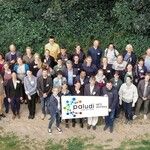
A simple word for an entire concept - paludiculture was first mentioned in a publication in 1998. An idea as old as Methuselah and today an important game changer, according to its creator. At an anniversary celebration an entire network of paludiculture projects was founded. It is expected that paludiculture will continue its success story.
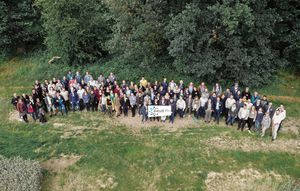
The word paludiculture was born 25 years ago. A "simple" word had to be found for an entire concept: rewetting drained peatlands to stop the emission of greenhouse gases and using it in a new, sustainable form of agriculture. It is made up of two Latin words, palus for swamp and cultura for cultivation. Hans Joosten first published it in 1998 in an essay entitled "Peat as a renewable resource: the road to paludiculture".
A lot has happened since then. This was demonstrated at the celebration of the 25th anniversary of the term, with scientific contributions, a panel discussion and poster session and about 200 participants, organized by the Thünen Institute, the University of Greifswald and the Succow Foundation, the partners in the PaludiZentrale project, on 10th-11th June 2024 in Braunschweig. Pioneers tested paludiculture, research projects have looked at various aspects from sowing to certificates, politicians are dealing with it and companies are beginning to discover paludiculture as a market.
The concept is "as old as Methuselah", said Joosten in Braunschweig, but is now a game changer in the fight against the climate crisis. The professor emeritus sees rewetting and paludiculture as a moral obligation. In view of a world population of more than eight billion people and the net zero CO2 emissions required to combat the climate crisis, every tonne must be offset immediately. According to Joosten, offsetting climate-damaging products or behaviour in which savers sell their emission reductions to others ("offsets") will no longer be possible after 2050, because "everyone will have to be at zero by then!" The friend of clear words and direct references says: "Peatland dewatering costs human lives". In order to achieve the climate targets set out in the Paris Agreement (2015), there is therefore no alternative to rewetting and sustainable use of peatlands - 50,000 hectares per year in Germany alone and 2 million hectares per year worldwide by 2050.
The collaboration in nine long-term projects was also celebrated. These founded the new PaludiNet network for the exchange of know-how and experience. The four ten-year model and demonstration projects (MuD) WetNetBB (Brandenburg), LivingLab Teufelsmoor, MOOSland and RoNNi (Lower Saxony) funded by the BMEL and the pilot projects BLuMo (Brandenburg), Klimafarm (Schleswig-Holstein), PaludiMV (Mecklenburg-Western Pomerania) and MoorWERT (Bavaria) funded by the BMUV, each of which also run for ten years, are now part of the network. Their common goal is to establish and manage paludicultures on a practical scale and to establish utilization and marketing chains for the biomass. PaludiZentrale networks and supports the practical projects, ensures uniform data collection, scientifically evaluates the results across the board and takes care of knowledge transfer.
Global Peatland Map 2.0!
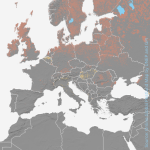
Now online: the Global Peatland Map, interactive, with several layers and free to download. Storymaps on peatlands on various continents will be added to this offer in the coming months.
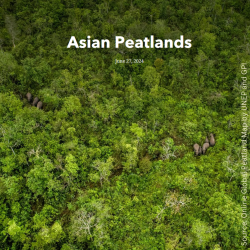
The GMC's Global Peatland Map is now available online and interactive! It comprises eleven pages and covers a wide range of topics, such as the extent of peatlands per country, greenhouse gas emissions, biodiversity hotspots, peatlands in protected areas and sources of fire. A series of story maps “Peatlands in the Continents” will complement the Global Peatland Map 2.0. for a detailed look at regions offering key facts on peatland distribution, degradation and options for action. Visually intuitive, easy to navigate and beautifully designed, a first story map on Asian Peatlands can already be tried out.
The web version of the Global Peatland Map is based on data from the Global Peatlands Assessment from 2022, which summarized the best available scientific data to provide an overview of the state of peatlands worldwide. As a partner in the Global Peatlands Initiative, the GMC's map specialists created the online version in close cooperation with the World Environment Situation Room of the United Nations Environment Programme (UNEP).
What's the problem?
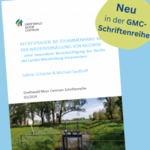
A new 209-page legal report comprehensively shows where the legal obstacles lie for the implementation of rewetting in Germany. And how they could be cleared out of the way...

There are legal obstacles to the rewetting of peatlands particularly in terms of land availability, planning and approval. This is shown in the new legal report Legal issues in connection with the rewetting of peatlands (in German), published in the Proceedings of the Greifswald Mire Centre. It offers a comprehensive analysis and shows possible solutions to ensure quick rewetting of peatlands and that they can contribute to natural climate protection as important carbon store and sink.
The German government's Natural Climate Protection Action Program aims to protect and strengthen endangered ecosystems such as floodplains, peatlands and forests - and to understand and remove the obstacles that stand in the way of restoring these valuable areas. The new legal report by Prof. Dr. Sabine Schlacke and Prof. Dr. Michael Sauthoff is an important contribution to this. It was produced within the project MoKKa - Peatland Climate Protection through Capacity Building, in which the Succow Foundation, the University of Greifswald and the Baltic Sea Foundation are working together. The results of the report were presented at the end of June 2024 at the "Expert Forum: Accelerating Natural Climate Protection - Improving the Legal Framework", which was jointly organized with the German Federal Environmental Foundation and took place in Berlin. The possibilities for implementing the legal policy recommendations were also discussed.
Climate, water, biodiversity in peatlands and floodplains
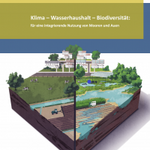
"Peatland protection is of public interest" - twelve scientists refer to the sentence in the current coalition agreement in a position paper by the Leopoldina. They emphasize the urgent need for restoration to combat climate-impacting gases from land use.

Climate, water, biodiversity - how this is connected in peatlands and floodplains, what state it is in and how it can be improved - summarizes the new Leopoldina position paper Climate - Water Balance - Biodiversity: For an integrative use of peatlands and floodplains. The 136-page paper by a working group of the same name at the National Academy of Sciences Leopoldina was published at the end of June 2024. "Nowhere in Central Europe is biodiversity as high as in these wetlands," says Leopoldina member Prof. Dr. Klement Tockner, Director General of the Senckenberg Gesellschaft für Naturforschung. Near-natural peatlands and floodplains are also essential for preventing flood disasters and reducing CO2 emissions. The position paper with supplementary digital dossier emphasizes the need to rewet peatlands and restore floodplains. Both are already established as climate and biodiversity goals, for the EU for example in the Nature Restoration Law recently adopted by the EU Environment Council and worldwide in the UN Convention on Biological Diversity. This provides for the protection and restoration of at least 30% of the world's land, freshwater and marine areas by 2030. The public interest of peatlands is also enshrined in the current German government's coalition agreement.
The position paper now presents options for action to achieve national and international commitments in climate, water and biodiversity protection and still be able to use these areas economically. This includes protecting intact peatlands, changing to paludiculture, honouring ecosystem services and including measures in CO2 emissions trading. Twelve scientists from the fields of ecology, biology, hydrology, sociology, agricultural engineering and environmental economics as well as law were involved - including Dr. Franziska Tanneberger and Prof. Jürgen Kreyling, two scientists from the Greifswald Mire Centre.
New funding opportunity for agricultural machinery
Good news from the BMUV: The German Federal Ministry for Environment is supporting the purchase of equipment for the careful management of wet peatland soils with 100 million euros from the Action Plan on Nature-based Solutions for Climate and Biodiversity (Aktionsprogramm Natürlicher Klimaschutz/ANK).
A new funding package should be of particular interest to farmers and nature conservation organisations: Investment funding for machinery and equipment to strengthen natural soil functions in agricultural landscapes. Up to 100 million euros are available to purchase machines that exert low pressure on the soil and thus contribute to the long-term preservation of a good soil structure. They will enable wet peatland to be worked gently, grassland to be farmed extensively and weeds to be controlled mechanically. With this measure, Federal Minister for Environment Steffi Lemke wants to support farms not only in rewetting, but also in the careful cultivation of wet peatland. The term of this directive is limited until 31.12.2026.
Like people, only wetter
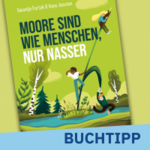
Curious human-peatland parallels in the new popular science book by Swantje Furtak and Prof Hans Joosten make it anything but a dry reading!

"Peatlands are like people, only wetter"! Another small difference: with humans you see first death first while in peatlands you first see live: with age, peatlands get bigger, fatter and get wrinkles. Hans Joosten and Swantje Furtak explain how this is meant and assemble other curious people-peatland connections in their new book (in German), with the same title. They dispel the myth of bog bodies, because no-one in the history of mankind has ever sunk into a peatland by accident. They constate that everyone in developed countries eats peat every day and that peat also exists in outer space. There it is called star-tar. Above all, the book explains in an easy and lively way, why peatlands are important for us all as climate protectors. There is one thing close to the hearts of the journalist and the professor emeritus of peatland science at the University of Greifswald and co-founder of the Greifswald Mire Centre: people and peatlands need to find a good way of living together and that can work!
"Peatlands are like people, only wetter" (176 pages, 20 euros) with many illustrative graphics, in the style familiar from Katapult magazine, and was published by Katapult-Verlag.
A project presented
Biochar Integration
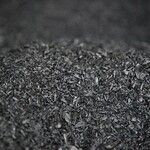
Scientists say adding biochar to rewetted lowland peat soils could ensure paludiculture farming models are financially viable for farmers, boosting efforts to mitigate climate change.

Biochar is a charcoal-like substance produced when biomass, such as agricultural waste or forestry residue, is heated up at very high temperatures without oxygen. It has a high carbon content and is largely resistant to decomposition, making it an ideal tool for long-term carbon storage.
While paludiculture may offer substantial emission reductions, theyare not as profitable as the typical crops grown on highly productive drained farming systems. Therefore, many farmers are unable or reluctant to adopt wet farming.
If cost-effective ways of applying biochar to soils can be established and ongoing UK trials can quantify its carbon storage potential, then this would enable farmers to gain an additional source of income from carbon financing. This would involve the sale of the carbon benefits from these practices as credits, for example, to companies who wish to offset their CO2 emissions.
The project Overcoming financial barriers for paludiculture adoption led by the UK Centre for Ecology & Hydrology (UKCEH), funded by a £500,000 grant from Natural England, is identifying cost-effective methods for biochar application under paludiculture conditions, maximising the ability of lowland peat soils to remove and store carbon.
In addition to biochar’s ability to capture and store carbon, it has been shown to improve local soil properties around roots, allowing the crop to access more nutrients and potentially boosting yields in mineral soils. This project aims to understand whether it can deliver improved yield benefits on peat soils and under paludiculture conditions to help further improve profitability.
Author: Jenny Rhymes, UK Centre for Ecology & Hydrology (UKCEH)
News from other paludiculture projects
International Projects
Wet Horizons: Rewetting according to plan
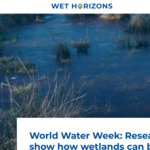
Rewetted peatlands can compensate for the strongly fluctuating amounts of precipitation, but only if rewetting is done correctly and sustainably. The Wet Horizons project is investigating which criteria can be used to classify the urgency of rewetting.

"The extreme weather events caused by climate change all have something to do with water: either too much or too little of it. Wetlands will become very important for regulating and supplying water in the future. We need to give wetlands and water back their place in our landscapes in order to mitigate extreme weather events, ensure the availability of water for people and nature and cool a heating environment," explains Dr Alexandra Barthelmes from the University of Greifswald, partner in the Greifswald Mire Centre.
The EU project Wet Horizons, together with its sister project REWET, which is also funded by the EU, aims to promote and optimise the rewetting of peatlands.
The project partners are updating maps of wetlands, creating an app and recommending guidelines for political decision-makers. But which peatland will become wet again first, and why? Research is the basis for this decision. It looks at greenhouse gas emissions and other ecosystem services that the rewetted peatland provides. For example, when a wetland improves the water quality in its surroundings, it is high on the list.
In order to find the best approach to rewetting, the researchers have installed seven so-called Open Labs. They reflect the different characteristics of the individual areas. The recommended management strategies are based on these in order to create an intact, species-rich ecosystem in the end. The results from the projects will become part of a guideline for the sustainable rewetting of peatlands.
German Projects
MOOSland: Peat moss harvest in the Hankhauser Moor
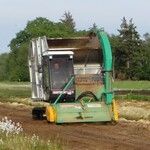
Great yield: the MOOSland project succeeded in harvesting over a thousand cubic metres of peat moss for high-quality growing media. A stress test for peat moss cultivators and the specialised machines from Dutch company Wellink Equipment.
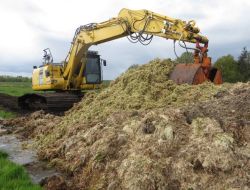
Last winter and in spring, over a thousand cubic metres of peat moss biomass were harvested from the peat moss paludiculture area established in the peatland Hankhauser Moor (NW Germany) in 2011. In addition to the tried-and-tested harvesting method using excavators and mowing baskets from the causeway, technology that can drive over the peat moss production areas was also tested at the MOOSland field day on 7th May 2024, where around 30 invited guests followed a harvesting test with a harvesting vehicle from Wellink Equipment. Layer by layer, the adapted Loglogic Softrak machine with flail mulcher removed a 40cm-thick peat moss lawn that had grown up over 13 years. It transported the biomass to the storage site using the semi-mounted bunker. The driver's sensitivity to the weight of the load on the wet, soft ground is crucial here. Torfwerk Moorkultur Ramsloh (MOKURA), the practice partner in the MOOSland joint project, processes the harvested peat moss biomass into high-quality growing media for professional horticulture.
Invitation: TyphaSubstrat presents results

The TyphaSubstrat project aimed to reduce the amount of peat in pressed pots for vegetable cultivation by at least 50%, primarily by using cattail as an admixture. The results show that it is possible. The researchers will present these at the final public event on 5th September 2024 in Darmstadt.
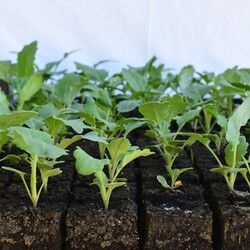
The aim of the three-year TyphaSubstrat project - harvesting and using cattail as an alternative substrate starting material for press potting soil in vegetable growing - was to develop a peat-reduced press potting soil with at least 50% less peat. The focus was on cattail mixed with other peat substitute components such as peat moss, green waste compost and wood fibres for press pots, on which lettuce and vegetables are grown commercially. In addition, the project also dealt with the development of technology for the harvesting of cattail as well as the investigation of cattail raw material with regard to substrate properties, pesticides and herbicides. At the final event on 5th September 2024 in Darmstadt, the project participants will present their results. Lectures and discussions in the morning at the Forschungsring e.V. in Darmstadt will be complemented by a tour of the practical tests in a vegetable nursery and a seedling farm near Mannheim.
By reducing peat and using paludiculture biomass, TyphaSubstrat makes a dual contribution to the transformation towards climate-friendly use of peatlands. The proven suitability of cattail biomass as an alternative substrate offers the industry a new renewable raw material that can be produced regionally. A step towards a long-term secure and climate-friendly raw material supply and a contribution to peatland protection. Project partners are the University of Greifswald, Forschungsring Darmstadt e. V. and Wellink GmbH. TyphaSubstrat is funded by the Federal Ministry of Food and Agriculture via the Agency for Renewable Resources (Fachagentur für nachwachsende Rohstoffe e.V.)
MOORuse: Final report with new findings
Replacing glass fibres with renewable raw materials from paludiculture could be possible in the future, according to the final report of the MOORuse project. It presents initial findings, but emphasises the need for further research...
Biogenic polymers are materials that are obtained from natural raw materials. Engineers like to use fibres to increase the stability of the polymer. In the MOORuse project, engineers experimented with fibres made from paludiculture biomass. They produced mixtures with different proportions of polymers and fibres and tested them for their properties, for example for injection moulding or 3D printing.
The result: although the addition of fibres from paludiculture biomass did not bring any advantage over other fibres, and therefore did not improve the composite material, the paludiculture fibres are still superior in terms of sustainability.
The researchers found that fibres from paludiculture were only suitable as reinforcement to a limited extent. Prior sorting according to leaf, bast, seed and woody material could lead to better results. It has also been shown that a silicate layer often covers the surface of paludiculture fibres. This makes bonding with the polymer difficult. Certain additives minimise this problem. However, too high a proportion of additives reduces the quality of the mixture. The researchers therefore consider the development of a suitable additive tailored to paludiculture fibres to be essential.
Biogenic polymers from paludicultures are just one aspect of the final report of the six-year MOORuse project on fenland soils in Bavaria. On a total of 250 pages, the report offers experiences and suggestions on the establishment of paludicultures, climate relevance and environmental effects, utilisation possibilities and economic efficiency. The report also offers a treasure trove of new findings on the thermal utilisation of paludiculture biomass as a source material for biogas plants, bedding and roughage in animal husbandry.
The project was funded by the European Regional Development Fund and coordinated at Weihenstephan University of Applied Sciences in Triesdorf.
Events
All current events are compiled in our online calendar.
Literature
Breznikar, A., Pönisch, D. L., Lorenz, M., Jurasinski,·G., Rehder, G. & Voss, M., 2024: Rewetting effects on nitrogen cycling and nutrient export from coastal peatlands to the Baltic Sea. Biogeochemistry DOI: 10.1007/s10533-024-01149-9
Ema, E.P., Mulyana, A., Adriani, D., Antoni, M., 2024: Perceptions of farmers regarding peatland restoration model of paludiculture in South Sumatra, Indonesia. Heritage and Sustainable Development, 6(1), pp.315-334. DOI: 10.37868/hsd.v6i1.418.
Gaudig, G., Prager, A., Krebs, M., 2024: How to promote Sphagnum lawn establishment in drained bogs: the role of water table and moss vitality. Mires and Peat, 31 (06), 22pp. DOI: 10.19189/MaP.2023.OMB.Sc.2305346
Giblett, R., 2024: Wetland Plants and Aboriginal Paludiculture in North-and South-Eastern Australia. Plant Perspectives, 1(1), pp.96-119. DOI: /10.3197/whppp.63845494909708.
Jaszczuk, I., Jablonska, E., Kozub, L., Tanneberger, F., Aggenbach, C., Seeber, E., van Diggelen, R., Kreyling, J., Silvennoinen, H.M. & Kotowski, W., 2024: Peat formation potential of temperate fens increases with hydrological stability. Science of The Total Environment 947: 174617. DOI: 10.1016/j.scitotenv.2024.174617
Kayatz, F., Kott, M., Tomei, L., Föllmer, M., Springer, A., 2024: Sustainable Packaging Solutions from Paludicultures: Potential and Challenges. SOFW Journal (English version), 150(5).
Quadra, G.R., Käärmelahti, S.A., Fritz, C., Temmink, R., 2024: Healing Peatlands to Protect Our Planet. Frontiers for Young Minds, 12. DOI: 10.3389/frym.2024.1124589.
Sanhueza, J.S., Gaudig, G., Krebs, M., Navarro, I.M. & Labbé, F.S., 2024: Turberas y cosecha de Sphagnum en la región de Aysén, Chile. Ciencia & Investigación Forestal. Vol. 30, 43-63. DOI: 10.52904/0718-4646.2024.606
Stivrins, N., Bikše, J., Jeskins, J., Ozola, I., 2024: Hands-On Approach to Foster Paludiculture Implementation and Carbon Certification on Extracted Peatland in Latvia. Land, 13(2), p.188. DOI: 10.3390/land13020188.
Theuerkauf, M., Nehring, E., Gillert, A., Bodien, P.M., Hein, M. & Urban, B., 2024: First automatic size measurements for the separation of dwarf birch and tree birch pollen in MIS 6 to MIS 1 records from Northern Germany. Ecology and Evolution, 14:e11510; DOI: 10.1002/ece3.1151
van den Berg, M., Gremmen, T.M., Vroom, R.J., van Huissteden, J., Boonman, J., van Huissteden, C.J., van der Velde, Y., Smolders, A.J., van de Riet, B.P., 2024: A case study on topsoil removal and rewetting for paludiculture: effect on biogeochemistry and greenhouse gas emissions from Typha latifolia, Typha angustifolia, and Azolla filiculoides. Biogeosciences, 21(11), pp.2669-2690. DOI:10.5194/bg-21-2669-2024.








